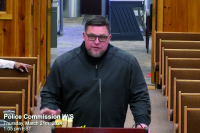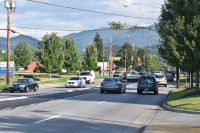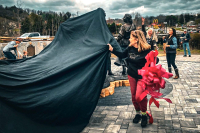Gift of the Mountains: Rooted in the Mountains connects Cherokee past and global future
It was an hour and a half after sunrise, and the day’s first rays had not yet touched Judaculla Rock, hidden away in a hollow near Caney Fork in Jackson County.
“I would encourage you to come back at different times,” T.J. Holland, cultural resources supervisor for the Eastern Band of Cherokee Indians, told the group assembled around him. “It’s one of these fascinating things — time of the year, time of day, weather all affects how this looks, and I’ve not been here twice that I’ve not seen something different.”
Vandalism at Judaculla: Leaders discuss how to protect Cherokee landmark
 When Jerry Parker walked by Judaculla Rock on March 26, he saw that some newer markings covered the rock’s millennia-old Cherokee carvings. A symbol written in white spray paint blazed the rock’s center, black paint circled a pair of round rises near the bottom, and sets of initials covered the beams of the boardwalk surrounding the historic site.
When Jerry Parker walked by Judaculla Rock on March 26, he saw that some newer markings covered the rock’s millennia-old Cherokee carvings. A symbol written in white spray paint blazed the rock’s center, black paint circled a pair of round rises near the bottom, and sets of initials covered the beams of the boardwalk surrounding the historic site.
Film crew granted access to Judaculla Rock
A film crew with the show “American Unearthed” will arrive in Jackson County this week to film an episode on Judaculla Rock, despite fears that a mockery will be made of the prehistoric rock art.
Storied Judaculla Rock gets overdue recognition
 Judaculla Rock, a prehistoric gem of the Cherokee and the most heavily inscribed petroglyph in the East, is putting Jackson County on the map.
Judaculla Rock, a prehistoric gem of the Cherokee and the most heavily inscribed petroglyph in the East, is putting Jackson County on the map.
Land surrounding Judaculla Rock now protected
Jackson County resident Jerry Parker has entered a conservation agreement on 107 acres to help protect the ancient petroglyph Judaculla Rock in the Caney Fork valley in Jackson County.
The large, soapstone boulder is carved with hundreds of symbols carved in pre-historic times. Parker’s property surrounds the rock.
The land conservation is part of The Judaculla Rock Preservation Project, which is devoted to preventing further environmental damage to the rock, protection of the environment around the rock and helping people enjoy their visits to the site.
The Land Trust for the Little Tennessee completed the conservation easement in late December.
The conservation agreement ensures the surrounding property won’t be developed, and includes a corridor for Jackson County’s planned greenway.
Memoir project a mixed bag
The design of this book’s cover, in addition to being visually attractive, quite possibly serves as an inadvertent assessment of this book’s contents:
Judaculla Rock, in all of its ancient splendor, serves as a backdrop for a diverse collection of objects - a dulcimer, a collection of wild flowers in glass containers, an ancient (fossil) stone displayed on a blue towel, an electric guitar and a laptop computer. The diversity of the objects suggests the eclectic (and possibly incompatible) nature of this book’s contents.
Appalachian Roots has two authors: Dave Waldrop and Michael Revere. Consequently, this book consists of two sections — an autobiographical account of Waldrop’s life, followed by a kind of miscellany of Michael Revere’s writings (essays, poetry, journals, etc.). Aside from a common cultural bond and friendship that these two authors apparently enjoy, Waldrop and Revere seem to have little in common.
Waldrop reveals a profound love for his family, a reverence for American values and all things “Appalachian,” especially music. Revere alternates between heartfelt homages to people and topics that he admires (Wilma Dykeman, the Church of God, and rock and roll) to bitter denunciations of consumerism, the wealthy landowners in Highlands, and America’s obsession with materialistic values. In addition, he condemns what he perceives as a moral/political betrayal of this country in a rash of vitriolic poems and essays attacking topics as diverse as academia, Richard Nixon, and James Dickey.
The heart of Waldrop’s autobiography stresses three themes: love, family and forgiveness. The author celebrates his abiding love for his mother and gives a painful account of the numerous indignities that she suffered as the wife of an alcoholic. Much of Waldrop’s account of his childhood depicts a family that is often precariously balanced on the brink of ruin — where love, survival and shelter are dependent on the whims of a drunken, perverse father who is capable of shockingly brutal attacks on his wife, often beating her into unconsciousness. Time and time again, young Dave and his brothers (and single sister) are forced to flee the Waldrop home in order to take shelter with relatives. Invariably, the family returns with the vain hope that the unstable father and husband will repent.
Although the primary focus of Waldrop’s story concerns his father’s tragic addiction and demise, Waldrop has vivid memories of humorous and joyful events. There is a wonderful account of a midnight ride in a car with half-deflated tires down a Jackson County railroad track. Then, there is Chuckie, a groundhog that became a household pet. At another point in his life, young Waldrop discovers a cure for chiggers: a plunge into the black, toxic waters of Tuckaseigee River (toxic because of the extract released into the creek by Mead Paper) would kill fleas, ticks and chiggers.
Waldrop also found a number of opportunities to excel in school, sports and part-time employment. Rejected by his father, Waldrop found the acknowledgment that he desperately craved elsewhere. Eventually, this same yearning for acceptance and approval would lead him to success in the military service and in his employment in the Jackson County schools system as a counselor, coach and bus driver.
Michael Revere’s contribution to Appalachian Roots comes under the heading, “Soul Harvest.” It is difficult to describe and/or evaluate Revere’s writing. It runs the gamut from doggerel verse and haiku to journalistic accounts of his personal encounters with “spirit lights” and extraterrestrials. In addition, Revere also gives a description of his ability to compel Air Force jets and the CIA to do his bidding. Michael readily admits that an early experience with LSD brought about a drastic change in his personality. Following this drug experience, Revere receives an honorary discharge on the grounds that he had developed “unsuppressable (sic) nomadic tendencies” that compel him to travel. For almost 40 years, Revere has been a rootless wanderer, living briefly in Oregon, Chapel Hill, Brevard, Montana, West Virginia and numerous small towns in between.
“Soul Harvest” contains more than 130 poems, journal entries and essays. At times, many of the poems contain a kernel of insight into human suffering love and joy.However, a considerable number of the poems and prose pieces are either angry, incoherent or offensive. Frequently, Revere appears to relish an “in your face” approach which is designed to shock his readers, as in “The Fried Baby Hillbilly Brain Vision,” “Carolina Hog Slaughter,” and “The Deliverance Vision.” Revere seems to have a compulsion to confront “famous” folks such as the folksinger Pete Seeger, the poet John Beecher and the novelist James Dickey.
One of the most provocative sections in “Soul Harvest” deals with a series of journal entries titled “Sky/Space Journal.” Revere believes that he can communicate with the “spirit lights” which pulse, move and dance in the night skies above Cullowhee. According to Revere’s journal, he monitors the night sky for months, both in North Carolina and other locations, and feels that he can establish direct contact with a host of alien beings.
At times, Revere has a disarming honesty about his own frailties and is perfectly willing to concede the fact that he is mentally unstable. He readily admits that his erratic home life (parents who were CIA agents, mother’s alcoholism, his confused identity due to changing his name, etc.) and his belief that he is an unwitting pawn in a covert CIA experiment — all have contributed to his confused and contradictory response to life. One thing is certain. This footloose, Church of God, drummer/rock-and-roller, poet and UFO fan is an original.
Does Appalachian Roots have problems? Yes, it does. Although this book is deeply moving at times, it could have used some serious editing and revision. It also needs a preface! There is no attempt to define this book’s purpose. Why did Waldrop and Revere join forces? What did they set out to accomplish?
There is also a lot of repetition. Waldrop repeatedly catalogues all the trees growing around his home; he repeatedly names all of the vegetables in the family garden, and he repeatedly proclaims his intent to never drink alcohol or judge his fellow man. On the other hand, he does not tell the reader enough about some of the book’s most provocative episodes. Waldrop avoids giving descriptive details. Specifically, what did his father say and/or do that was unforgivable? What are the physical characteristics of his brothers and his sister? The family’s three horses? All of these characters and creatures simply beg to be developed.
However, in spite of the absence of descriptive details, Appalachian Roots captures the essential facts in two very different (but equally daunting) journeys to adulthood in Appalachia. I would like to think that there will be a sequel to this book — an autobiography that tells us all of the details that were absent in this one.
Appalachian Roots, by Dave Waldrop and Michael Revere. R&R Publishing, 2010. 244 pages.
The mystery of Judaculla Rock
Located in a field in the rural Caney Fork community of Jackson County is Judaculla Rock, a soapstone boulder covered with mysterious carvings. The lines, circles and squiggles appear to form distinct shapes, but exactly what they mean, and who carved them, is a source of much debate.
As long as 5,000 years ago, prehistoric Native Americans used the area around Judaculla to mine soapstone, a rock valued for its heat-retaining properties. The Cherokee, later residents of the area, considered the site to be sacred. The first carvings on the Judaculla Rock appeared about 1,500 years ago. According to Cherokee legend, they were created when Tsul-Kalu, the Great Slant-Eyed Giant, jumped from his home on the ridge above to the valley below, leaving a strange imprint.
Over time, others have tried to decipher the symbols. Are they a map of the area? The story of a hunt? Religious, perhaps? Often, different people see different things contained in the carvings.
“Depending on different people’s perspective, the eye will form different connections,” says Laurie Hansen with the North Carolina Rock Art Survey. “However, what the original person was intending to convey or put there, we’re not sure.”.
Saving Judaculla Rock: Preservation work begins on local artifact
By Julia Merchant • Contributing writer
Priceless artifacts often end up tucked safely away behind the protective glass cases of museums — but not Judaculla Rock.
A thin, twisted piece of rusty rebar is all that separates this well-known boulder, covered with mysterious Native American petroglyphs, from the thousands of visitors who flock each year to the rural Jackson County field where the rock lies. A few hastily tacked newspaper articles do little to convey the importance of this sacred prehistoric site.
“Judaculla tends to be one of the most complex boulders in terms of the amount of glyphs carved into it, and it’s one of the only public rock art pictographs in the state,” said Lorie Hansen, project director of the North Carolina Rock Art Survey. “It’s not currently being protected environmentally or from visitors.”
But that’s going to change, thanks to efforts spearheaded by Jackson County, the Eastern Band of Cherokee Indians, the North Carolina Office of State Archaeology and the Caney Fork Community Development Council. Last month, the county released the findings of a soil survey conducted on the site in July — the first step of a comprehensive management plan for the artifact that will one day result in a boardwalk, more signage, and erosion and sediment control features.
“I think all the commissioners feel an obligation to take care of it,” said Emily Elders, Recreation Project Manager for Jackson County. “It’s a local landmark.”
Taking action
Over the years, a variety of forces — mostly human — have caused a great deal of damage to Judaculla. Visitors have highlighted the petroglyphs with chalk, talc powder, and shoe polish in an effort to see them better. At least twice, someone has attempted to remove sections of the rock, possibly for a souvenir; others have left behind graffiti or carved their initials. People have stood on the boulder and used it as a mountain bike ramp.
In the past, the county has made some efforts to preserve and protect Judacualla, but even those did more harm than good. A roofed cinder block building constructed over the boulder in the 1960s created a moist environment that enabled the growth of lichen. The roof was later replaced by an open structure, which caused increased sedimentation.
“What you see invariably is people trying to do the best they knew to do at the time to save it and help it,” said Elders. “I think it’s always been motivated by a desire to do right by the site.”
The need to do something more to preserve Judaculla, however, became more urgent in recent years.
“Many people in this part of the state had become aware of Judaculla and the effects on it from visitors and weathering forces,” said Hansen. “We started a committee to talk about what could be done. Jackson County was very responsive and contributed funds to get a conservation plan developed.”
In 2008, the county commissioners asked Georgia-based Stratum Unlimited to develop a comprehensive management plan that would address ways to alleviate damage to the boulder. Authored by renowned archaeologist Jannie Laobser, the report found that the accumulation of soil and sediment around the rock was “of specific concern,” and had accelerated in recent years, obscuring and eroding the petroglyphs.
The report noted that the boulder was still in remarkably good shape, considering all the damaging factors it had been subjected to over the years. However, it also stated that while the county could continue to press its luck, it also had the opportunity to grab the reins and take a proactive approach to preserving Judaculla.
“The fact of the matter is that the site cannot escape being ‘managed,’ be it in an informal or ‘chaotic’ fashion by the visiting public, or in a more formal, or planned, fashion by the county,” wrote Laobser.
Community effort
The county, joined by multiple state and local agencies, stepped up efforts to preserve Judaculla. The Eastern Band of Cherokee Indians was also eager to help protect the site, considered sacred in Cherokee culture.
“In a sense, the Cherokee have a cultural ownership of Judaculla Rock,” says Brian Burgess of the Tribal Historic Preservation Office. “I imagine it’s difficult for any Cherokee citizen, young or old, to visit the rock, and not appreciate the time and work that went into the creation of the glyphs, and not feel some type of spiritual connection to the people that carved the images so long ago.”
The Cherokee Preservation Foundation gave $17,000 to help fund the conceptual site plan for Judaculla.
With the help of public input, it was determined that the best way to preserve Judaculla would be to restore historical stormwater flows and grades to reduce or eliminate the sedimentation that was burying and eroding the rock. But just what was “historical?”
“We don’t have any real records of what the land used to look like around the rock,” said Elders. “When we talk about trying to restore the normal water flow, it makes sense to ask, was anything ever being grown there? Was there a hill behind (the rock) originally? That’s what we were really looking for.”
To gather historical information, the group resorted to creative means.
“We relied on photographs a lot. We ran an ad in all the papers and with the Oklahoma Cherokee Nation and Eastern Band asking for stories, legends, or information about Judaculla rock,” said Elders. “We got all kinds of stuff. People brought in copies of old postcards, old articles, some Citizen-Times articles on microfiche, old pictures.”
The information helped the county complete a site plan for Judaculla, which was released this past May.
New look
Under the site plan, the rusted rebar which currently serves as the sole barrier around Judaculla would be replaced by a raised viewing platform closed in by railings, The plan also calls for the installation of interpretive signage, which would inform visitors about the archaeological significance of the site, explain the Cherokee legend associated with Judaculla, and detail the more recent history of the Caney Fork area.
A major focus of the plan is getting rid of the sedimentation that has damaged Judaculla over the years. The area’s natural slopes and vegetation will be restored to reduce stormwater runoff. The county is also pursuing a conservation easement that would move access to Judaculla away from the uphill slope above the rock, where visitors currently park.
“That would eliminate a lot of the erosion problem coming from the road. The goal is to get rid of some of the traffic,” said Elders.
Instead, visitors would park further away from the rock and walk along a six-foot wide, compacted gravel access trail.
Preservation begins
Implementation of the site plan began this past July, when a week-long soil sampling survey was conducted at Judaculla. More than 100 soil core samples were extracted around the site and examined to help determine what the natural flow of water had once looked like around Judaculla. The findings will help determine the design and placement of surface water runoff facilities and serve as a guide for removing the soil that has built up to obscure some of the petroglyphs.
The eventual goal is to return the soil surrounding the rock back to the level it was in the 1920s, the last time it was a “natural situation,” says Elders. “After that, there was artificial, exacerbated erosion coming in.”
It’s unclear how much more of the rock will be exposed when the soil buildup is removed, since pictures of Judaculla from that time are rare. But Elders says the process will expose more of the rock’s carvings, and will be followed up with stormwater and erosion protection measures to ensure soil buildup is kept to a minimum.
The next step in implementing the site plan is already underway. Equinox Environmental was awarded a contract last month, funded by the Cherokee Preservation Foundation, to start engineering some of the drainage and erosion control measures.
Putting the whole site plan in place, however, could take some time.
“It’s a multi-year kind of project broken down into stages,” Hansen said.
Slowing the process is Judaculla’s designation as a state historic site. Archaeologists must approve plans for and be present at each state of site work, in case artifacts are turned up in the process. That requirement is the costliest part of the preservation effort. “The actual construction is not that costly,” Elders said. She said she doesn’t know how much the whole project could end up costing, but will seek out grants to help pay for it.
The whole process of preserving Judaculla may seem painstaking, but it must be that way so the mistakes of past preservation attempts can be avoided, Hansen said.
“We want to make sure it’s the right thing for the site, because in years past there’ve been very good attempts on the part of the county to protect it that turned out to be to its detriment,” Hansen said.





